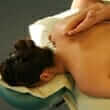Background
- Rolfing® Structural Integration involves deep tissue massage aimed at relieving stress and improving mobility, posture, balance, muscle function and efficiency, energy, and overall well being. Practitioners apply slow-moving pressure with their knuckles, thumbs, fingers, elbows, and knees to the muscles, tissue around the muscles, and other soft tissues. Rolfing® Structural Integration, also called somatic ontology, concentrates on opposing muscle groups, such as the biceps and triceps in the upper arms.
- The methods used in Rolfing® were developed in the 1950s by Dr. Ida P. Rolf, based on the belief that imbalances in body structure can be corrected by manipulating the soft tissue networks of muscle, fascia, tendons, and ligaments. In 1971, Rolf founded The Rolf Institute of Structure Integration in Boulder, CO, which currently owns rights to the registered mark Rolfing®. However though the term rolfing is also used for various therapies based on the teachings of Rolf.
References
- Bernau-Eigen M. Rolfing: a somatic approach to the integration of human structures. Nurse Pract Forum 1998;9(4):235-242.
View Abstract - Cottingham JT, Maitland J. A three-paradigm treatment model using soft tissue mobilization and guided movement-awareness techniques for a patient with chronic low back pain: a case study. J Orthoped Sports Phys Ther 1997;26(3):155-167.
View Abstract - Cottingham JT, Porges SW, Lyon T. Effects of soft tissue mobilization (Rolfing pelvic lift) on parasympathetic tone in two age groups. Phys Ther 1988;68(3):352-356.
View Abstract - Cottingham JT, Porges SW, Richmond K. Shifts in pelvic inclination angle and parasympathetic tone produced by Rolfing soft tissue manipulation. Phys Ther 1988;68(9):1364-1370.
View Abstract - Deutsch JE, Derr LL, Judd P, et al. Treatment of chronic pain through the use of structural integration (rolfing). Orthopaedic Phys Ther Clin North America 2000;9(3):411-425.
- Franco R, Camacho FI, Fernandez-Vazquez A, et al. IgV(H) and bc16 somatic mutation analysis reveals the heterogenicity of cutaneous B-cell lymphoma, and indicates the presence of undisclosed local antigens. Mod Pathol 2004;17(6):623-630.
View Abstract - Goffard JC, Jin L, Mircescu H, et al. Gene expression profile in thyroid of transgenic mice overexpressing the adenosine receptor 2a. Mol Endocrinol 2004;18(1):194-213.
View Abstract - Jones TA. Rolfing. Phys Med Rehabil Clin N Am 2004;15(4):799-809.
View Abstract - Kerr HD. Ureteral stent displacement associated with deep massage. WMJ 1997;96(12):57-58.
View Abstract - Perry J, Jones MH, Thomas L. Functional evaluation of Rolfing in cerebral palsy. Dev Med Child Neurol 1981;23(6):717-729.
View Abstract - Rolf IP. Structural Integration. J Institute Compar Study History Philos Sciences 1963;1(1):3-19.
- Rolf IP. Structural integration: a contribution to the understanding of stress. Confin Psychiatr 1973;16(2):69-79.
View Abstract - Santoro F, Maiorana C, Geirola R. Neuromascular relaxation and CCMDP. Rolfing and applied kinesiology. Dent Cadmos 1989; 57(17):76-80.
View Abstract - Talty CM, DeMasi I, Deutsch JE. Structural integration applied to patients with chronic fatigue syndrome: a retrospective chart review. J Orthopaedic Sports Phys Ther 1998;27(1):83.
- Weinberg RS, Hunt VV. Effects of structural integration on state-trait anxiety. J Clin Psychol 1979;35(2):319-322.
View Abstract







